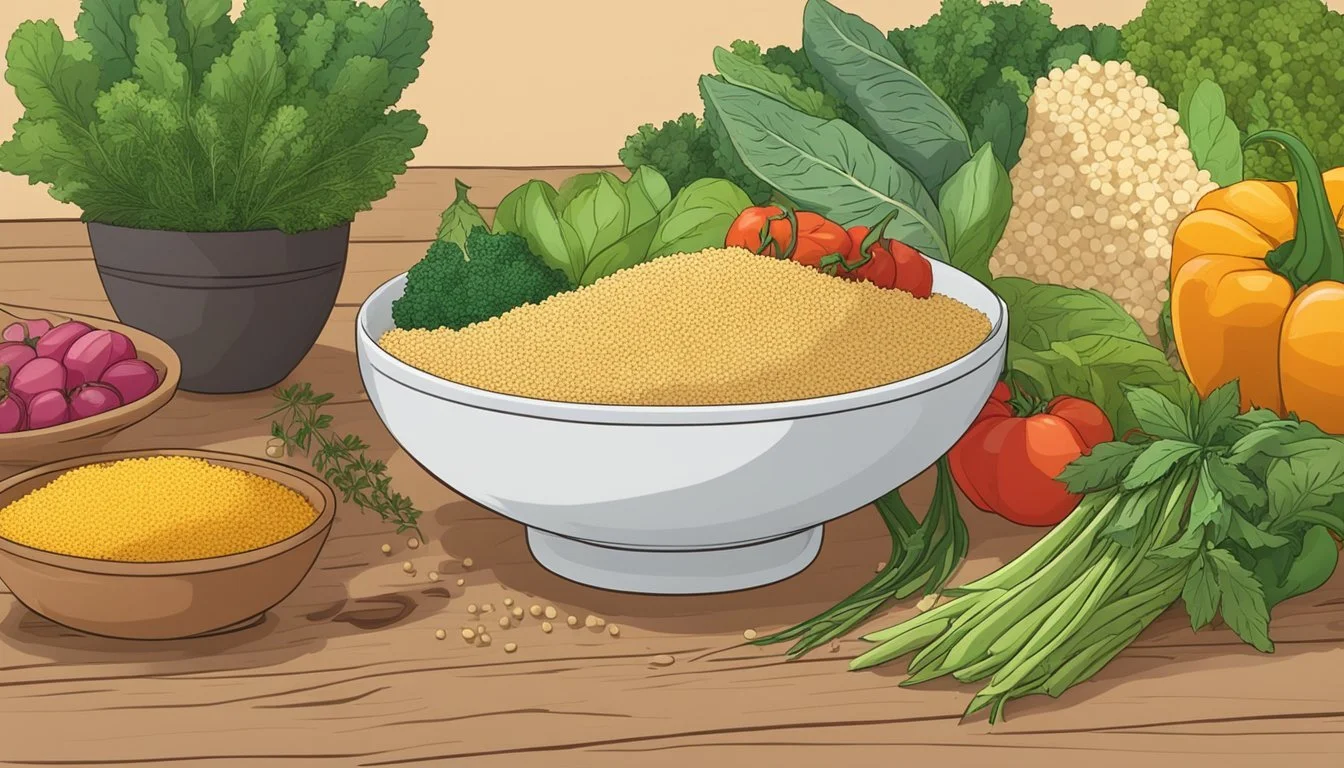Is Couscous Gluten-Free?
Understanding Its Ingredients and Alternatives
Couscous (What wine goes well with couscous?), a staple in North African cuisine, is often assumed to be gluten-free due to its rice-like appearance and the way it's served in a variety of healthy dishes. Yet, this small, granular pasta is traditionally made from semolina flour, which comes from durum wheat, a grain that contains gluten. Consequently, individuals with celiac disease or gluten sensitivity must avoid traditional couscous.
Gluten-free alternatives to couscous do exist, utilizing grains and starches such as corn, rice, or quinoa. (What wine goes well with quinoa?) However, when searching for gluten-free options, it's important to look for products that are explicitly labeled as such. These alternatives often attempt to mimic the light, fluffy texture of traditional couscous while providing a safe option for those adhering to a gluten-free diet.
What Is Couscous?
Couscous is a grain-based product revered for its culinary versatility and its fundamental role in North African cuisine. Its preparation typically involves steaming small pellets of dough derived from semolina flour.
Origins and Varieties
Couscous originated in the Maghreb region of North Africa and has been a staple food throughout countries like Morocco, Algeria, and Tunisia for centuries. The traditional form of couscous, known as Moroccan couscous, is approximately one millimeter in diameter. However, there exist several varieties:
Israeli Couscous: Also called pearl couscous, is larger in size and resembles small beads.
Lebanese Couscous: Similar to Israeli couscous, but even larger.
Couscous Composition
Couscous granules are made from semolina, coarsely ground durum wheat, mixed with flour, water, and sometimes salt. The mixture is rolled into tiny grains and then steamed. This primary ingredient distinguishes couscous from other grains such as barley, rye, or brown rice. It is important to note that due to its wheat content, traditional couscous is not gluten-free.
Celiac Disease and Gluten Sensitivity
For individuals with celiac disease or non-celiac gluten sensitivity, understanding these conditions and their relationship to gluten is crucial. A strict gluten-free diet is the only effective treatment to manage symptoms and prevent complications.
Understanding Gluten-Related Disorders
Celiac disease is an autoimmune condition in which the ingestion of gluten—a protein found in wheat, barley, and rye—triggers an immune response that damages the small intestine. This damage hinders the absorption of nutrients and can lead to a host of health problems. Non-celiac gluten sensitivity (NCGS), also referred to as gluten sensitivity or gluten intolerance, is a condition wherein individuals experience symptoms similar to those of celiac disease upon consuming gluten but without the associated intestinal damage.
Key differences between these disorders include:
Celiac disease: Autoimmune disorder; positive celiac-specific antibodies; intestinal damage visible upon biopsy.
Non-celiac gluten sensitivity: No autoimmune antibodies; no visible intestinal damage; diagnosis based on symptom relief upon starting a gluten-free diet.
A gluten-free diet is paramount for those with these conditions, which means avoiding all products containing wheat, barley, rye, and their derivatives. Some people may also have a wheat allergy, which is an allergic reaction to proteins found in wheat, not just gluten. Wheat allergy can cause itching, swelling, and difficulty breathing, unlike the digestive symptoms typically associated with celiac disease and NCGS.
Diagnosing Celiac Disease
The diagnosis of celiac disease involves several steps and typically requires:
Blood tests: Screening for specific antibodies such as tissue transglutaminase (tTG-IgA).
Genetic testing: Identifying HLA-DQ2 and HLA-DQ8 genes, which are found in the majority of those with the disease.
Endoscopy: Viewing and obtaining a biopsy of the small intestine is often necessary to assess damage caused by gluten consumption.
It is important for individuals to continue consuming gluten until all testing is completed, as removing gluten from the diet could alter test results. If the tests suggest celiac disease, the final diagnosis is confirmed by a positive response to a gluten-free diet. In contrast, non-celiac gluten sensitivity is diagnosed based on the resolution of symptoms once gluten is removed from the diet, as there is currently no definitive test for NCGS.
Is Couscous Gluten-Free?
In assessing whether couscous is gluten-free, two primary factors must be considered: the inherent gluten content in couscous and the risks of cross-contamination.
The Gluten Content in Couscous
Couscous is a grain product made from semolina, which is derived from durum wheat. It resembles rice but is actually small granules of processed wheat flour. Due to its wheat content, traditional couscous contains gluten, a group of proteins found in wheat, barley, and rye. Those adhering to a gluten-free diet should avoid standard couscous since it can trigger reactions in people with celiac disease or gluten sensitivity. However, some manufacturers offer gluten-free couscous, which is made from gluten-free grains like corn or rice.
Cross-Contamination Concerns
When dining at a restaurant or purchasing packaged foods, individuals following a gluten-free diet must be vigilant about cross-contamination. This happens when gluten-free foods come into contact with gluten-containing ingredients or equipment. Even if gluten-free couscous is on the menu, it is crucial to trust that the establishment follows strict protocols to avoid cross-contamination. Therefore, individuals requiring a strict gluten-free diet must confirm the gluten-free status and handling practices, whether at a restaurant or when buying alternative couscous products.
Gluten-Free Alternatives to Couscous
For individuals on a gluten-free diet, traditional couscous, made from durum wheat, is off-limits. However, numerous gluten-free alternatives provide similar textures and flavors, while adhering to dietary restrictions. These options include naturally gluten-free grains and specially manufactured products designed to mimic couscous.
Natural Gluten-Free Grains
Quinoa: A protein-rich seed that cooks up fluffy and can substitute couscous in most recipes.
Rice: Particularly short-grain rice, offers a sticky consistency quite unlike couscous but serves as a good base in meals.
Millet: A small-grained, nutrient-dense alternative that when cooked becomes light and fluffy.
Buckwheat: Despite its name, buckwheat is gluten-free and its groats can be a flavorful stand-in for couscous.
Sorghum: Its chewy texture can add depth to dishes that typically feature couscous.
Brown Rice: A whole-grain alternative that brings a nutty flavor and a chewier texture to dishes.
Manufactured Gluten-Free Products
Gluten-Free Couscous: Brands like Clearspring produce a corn-based instant couscous that is certified gluten-free.
Gluten-Free Pasta: Available in various shapes and sizes, pasta made from rice flour, cornmeal, tapioca starch, or a combination, can be a suitable replacement for couscous.
Cornmeal Couscous: Made from ground corn, it's used as a gluten-free couscous substitute with a distinct taste.
Cassava Couscous: Derived from cassava root, this alternative reflects the lightness of traditional couscous.
Fonio Couscous: A West African grain that is naturally gluten-free and can be used in a similar fashion to couscous.
These gluten-free alternatives not only ensure a diet free from gluten but also introduce a variety of flavors and nutritional profiles to meals traditionally based on couscous.
Incorporating Gluten-Free Alternatives in Recipes
With a rise in gluten sensitivity, offering gluten-free alternatives has become essential. This section focuses on how to seamlessly substitute couscous in dishes and provides specific gluten-free recipe ideas that maintain the integrity of Mediterranean and Middle Eastern cuisines.
Substituting Couscous in Meals
Substituting couscous with gluten-free options doesn't have to compromise taste or texture. Quinoa, a naturally gluten-free grain, is a favorite substitute for its similar size and versatility. It can be used in place of couscous in most recipes, offering a nutty flavor and a robust nutritional profile. Rice, especially small-grained varieties like Arborio, can mimic couscous in dishes, making for a smooth transition in salads and stews.
Gluten-Free Recipe Ideas
Creative gluten-free recipes abound for those looking to enjoy couscous-like dishes:
Quinoa Tabbouleh Salad: Replace bulgur with cooked quinoa and mix with parsley, mint, tomatoes, lemon juice, and olive oil for a refreshing salad.
Rice Pilaf: Use Arborio rice seasoned with aromatic spices, such as cumin and coriander, to achieve a fluffy texture and rich flavor.
Rice Cauliflower Couscous: Pulse cauliflower in a food processor until it resembles couscous. Sauté with a touch of olive oil, and herbs, for a low-carb, gluten-free dish.
Cooking with gluten-free grains requires adjustments. Quinoa should be rinsed to remove its bitter saponin coating before cooking, and rice may require different water ratios or cooking times compared to traditional couscous. However, with these considerations in mind, gluten-free cooking can be both delicious and nutritious.
Shopping for Gluten-Free Products
When adhering to a gluten-free diet due to celiac disease or gluten sensitivity, finding gluten-free alternatives to common foods like couscous is essential. The market offers specific brands known for their gluten-free options, and understanding labels and certifications can help ensure safe choices.
Identifying Gluten-Free Couscous Brands
Several brands have risen to prominence in the gluten-free market, offering products that ensure no gluten contamination and are safe for those with celiac disease. Notable brands include:
Gefen: Recognized for their kosher and GFCO-certified gluten-free couscous.
Bob's Red Mill: A well-known supplier providing a range of gluten-free products, including couscous substitutes.
Clearspring: Offers organic, gluten-free options which are clearly labeled for the ease of consumers.
Nayama: Although less common, some of their products are gluten-free and suitable for a gluten-free diet.
When shopping for gluten-free couscous at supermarkets or online, it is important to look for these brands and ensure the packaging explicitly states that the product is gluten-free.
Understanding Food Labels and Certifications
The Food and Drug Administration (FDA) has set a standard definition for "gluten-free," which means the product must contain less than 20 parts per million of gluten. When purchasing gluten-free products, look for the following on labels:
FDA Gluten-Free Certification: Products meeting the FDA guidelines will display a gluten-free label.
Gluten Intolerance Group Certification: Represented by a 'GFCO' symbol, this certification indicates strict standards of gluten testing.
Clear Ingredient List: Packaging should list all ingredients, including any that may suggest cross-contamination.
Certifications and clear labeling support consumers in making informed decisions and help maintain the health benefits of a gluten-free diet. Always check the labels for these confirmations to avoid unintended gluten ingestion, especially if you are dining out or choosing from a menu in a restaurant.
Eating Out on a Gluten-Free Diet
When dining at restaurants, patrons adhering to a gluten-free diet must be vigilant about menu choices and communicate clearly with the staff to avoid cross-contamination, particularly when considering dishes like couscous that are traditionally made from wheat.
Navigating the Menu
Selecting gluten-free options requires a careful examination of the menu. Mediterranean and Middle Eastern restaurants often feature couscous, which under standard recipes contains gluten. Diners should look for terms like "gluten-free couscous" on the menu, signifying that the dish is made from non-wheat alternatives such as corn or rice flour. It is also advisable to consider natural gluten-free options such as rice or quinoa as safe alternatives. To minimize the risk of cross-contamination, one should inquire whether the restaurant employs dedicated gluten-free preparation areas.
Menu Indicators: Look for clear labels such as 'gluten-free' or 'GF' next to menu items.
Safe Choices: Opt for inherently gluten-free dishes like grilled proteins and salads.
Ask Questions: If menu descriptions are vague, ask for details about ingredients and preparation.
Communication with Restaurant Staff
Direct and specific communication with restaurant staff is essential. Patrons should inform them about their dietary restrictions and ask about the steps taken to avoid cross-contamination in the kitchen. It's crucial to ascertain whether the restaurant is equipped to accommodate a gluten-free diet safely and if they offer gluten-free alternatives like couscous made from gluten-free grains.
Inform Immediately: As soon as seated, inform the server about the need for a gluten-free meal.
Verify Practices: Discuss the restaurant's practices to prevent cross-contamination, such as using separate cooking surfaces and utensils.
Clarify Doubts: If unsure about a dish, it's better to ask for clarification rather than risk exposure to gluten.





